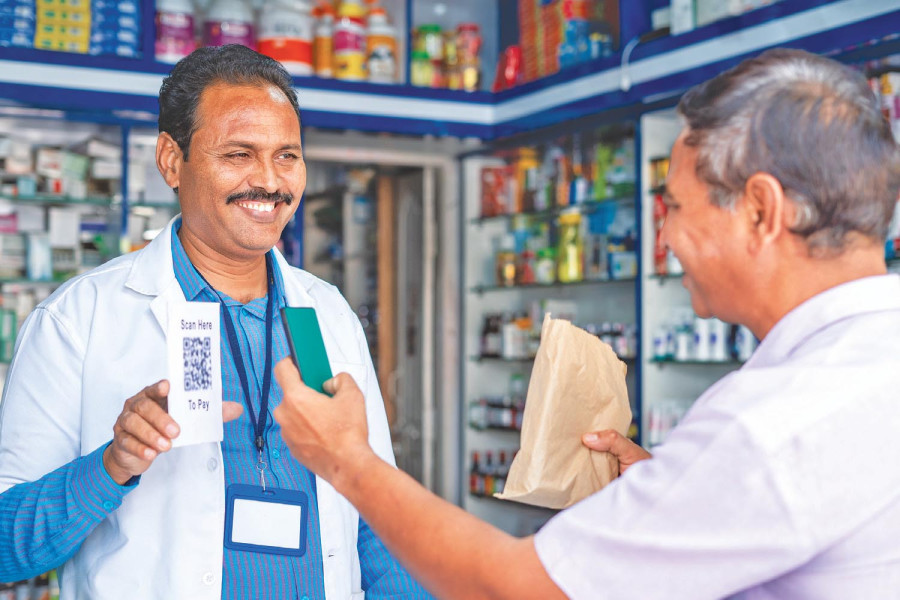Money
Central bank panel proposes monthly QR code payment limit at IRs100,000 for Nepalis in India
But the limit does not apply for payments to be made for services in hotels, hospitals and chemist shops in India.
Krishana Prasain
A panel formed by Nepal’s central bank has suggested capping payments made via quick response (QR) code for Nepali nationals in India at IRs 100,000 (Rs160,000) per month, either in one go or cumulatively.
However, there will be no limits for making payments through quick QR codes at hotels, hospitals (hospital and research centres) and medicine shops, according to a draft report prepared by the panel which has been published on the Nepal Rastra Bank’s website to collect suggestions from the public.
Likewise, to allow Nepalis to make online purchases of goods and services from third countries (whose currencies are convertible in Nepal) via QR code, the limit has been proposed at $2,000 a year. For making such purchases, the buyer must have a US dollar account in a Nepali bank, and the purchased goods or services should be used in Nepal. The panel has also suggested a separate provision for those without a US dollar account—such individuals can make online purchases of up to $500 only, per year. However, such account holders have to request their banks to convert the currency.
The panel has proposed that the charges for the QR code services should be determined by the market. However, the central bank can inspect the charges and limitations as needed, according to the draft report titled ‘Provisions related to international retail payments to be made through mobile and internet banking and inter-bank transactions through QR code.’
The panel made the draft public on Tuesday asking for suggestions and feedback.
These provisions are in line with the existing rules related to foreign exchange services.
On March 1, India launched the payment system through QR codes in Nepal.
Payments for purchases made through mobile phones have been seen as a milestone in cross-border digital payment between Nepal and India, addressing numerous hassles faced by citizens of both countries who rely on banknotes.
Although India implemented the system swiftly from March 1, the Nepali side has been dilly-dallying as the central bank said it would take time to set transaction limits for digital wallets. The bank then constituted a task force to set the transaction limits. The task force produced the draft report on Tuesday, subject to an approval by the Nepal Rastra Bank.
“We have kept the draft in the public domain seeking suggestions and have provided a month to give feedback. Once we receive suggestions and feedback, we will review the draft and implement the provisions, which will enable Nepalis to make payments using QR codes in India and other countries,” said Gunakar Bhatta, executive director at the Payment Systems Department of Nepal Rastra Bank.
He said that the proposed transaction limits for QR codes-based cross-border payment transactions are the same as payment in card systems.
Another central bank official said that if things go as planned, the cross-border payment service in India will begin by June.
On June 1 last year, Nepal and India signed a memorandum of understanding for cross-border digital payment to ease digital transactions for business people, students, and tourists from both countries.
On February 15 this year, Nepal Rastra Bank and Reserve Bank of India signed and exchanged Terms of Reference for interlinking the Unified Payment Interface (UPI) of India and the National Payment Interface of Nepal.
The integration is aimed at facilitating cross-border remittances between India and Nepal by enabling users of the two systems to make instant fund transfers at low costs.
According to the proposed draft report, all types of retail payments to be made through QR codes should be done through the National Payment Switch.
Payment service operators or banks and financial institutions using their own switches will have to acquire and issue QR codes accordingly to ensure that the payments are made through the National Payment Switch.
As per the memorandum of understanding between Nepal Clearing House and NPCI International Payment Limited of India, and the conditions enforced by two regulators—Nepal Rastra Bank and Reserve Bank of India—the personal payment transfer is the first phase of the cross-border electronic payment system between Nepal and India.
The central bank draft report says that once the ‘personal payment transfer’ system is implemented, the ‘merchant payment transfers’ will be implemented in the second phase.
According to the draft report, licensed organisations will not need to obtain permission from the central bank to hold preliminary discussions with foreign payment transaction companies for the use of retail payment equipment and integration for mobile banking and QR code transactions.
However, the licensed organisation will have to obtain a no-objection letter from the central bank for signing a memorandum of understanding with foreign companies to integrate retail payments through QR code.
According to Diwas Kumar Sapkota, chief executive officer of Fonepay, 600 transactions take place per day on average through QR codes from Indian visitors. He said that in terms of value, the transactions total Rs1.30 million daily.
“The transactions mostly increase during Indian holidays and have been mostly concentrated on the border areas.”
QR code display stands are now seen everywhere—from vegetable shops to department stores and private business houses to government agencies. The central bank data shows that transactions through QR codes have been growing at a faster pace each passing month.
In Nepal, according to the central bank data, in the month of mid-February to mid-March, the transactions made through QR codes amounted to Rs42.56 billion, the highest amount on record. Compared to the QR code transactions made from mid-January to mid-February, it has increased by 12.80 percent.




 15.69°C Kathmandu
15.69°C Kathmandu















